Los Angeles County
LA County Probation Oversight Commission releases report on education
“The youth in our juvenile halls and camps deserve classrooms that promote learning, healing, and successful re-entry into the community”
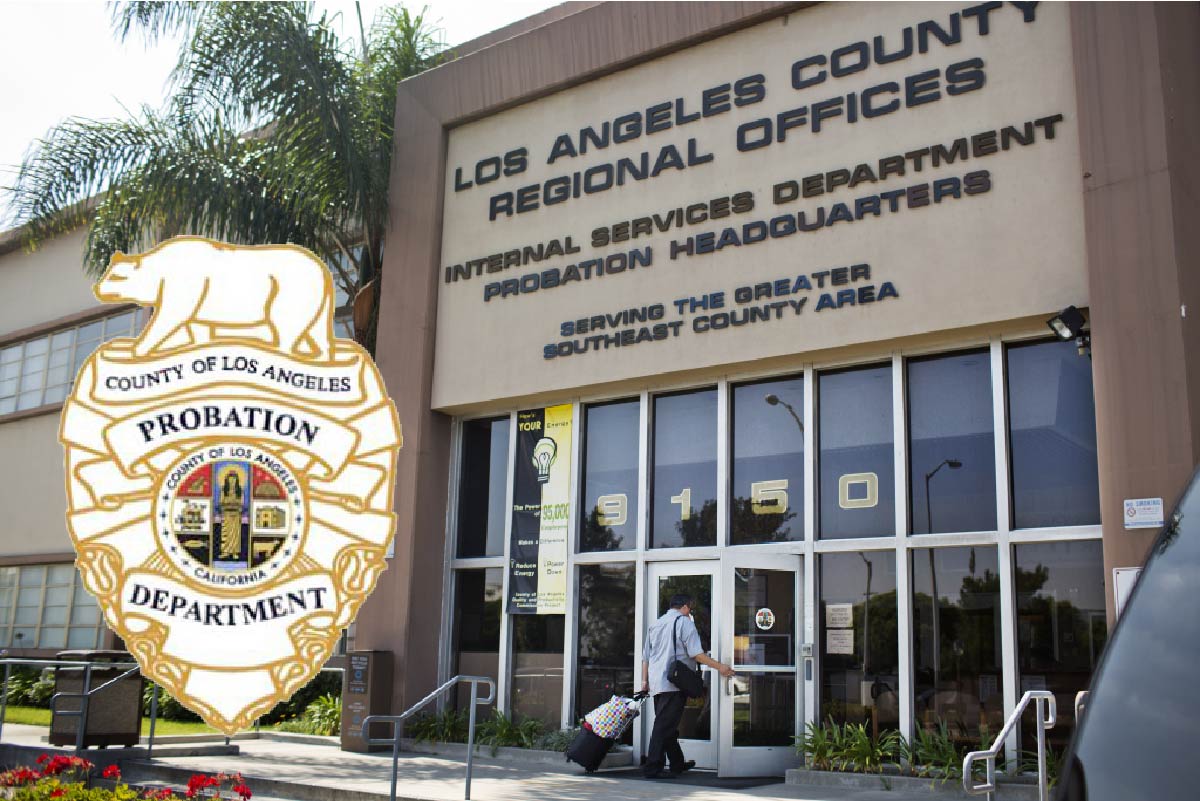
LOS ANGELES – The Los Angeles County Probation Oversight Commission presented and unanimously accepted a report on the state of education in Los Angeles County Probation juvenile halls and camps at a public special meeting today that highlighted four key findings from quality of instruction to staffing.
Commissioners shared their observations, findings, and recommendations based on months of classroom observations of interviews with staff, students, and education advocates in the Los Angeles County Office of Education (LACOE) juvenile court schools.
The report describes four key findings, explained through individual anecdotes and overall observations:
- Most classrooms lack a culture of learning
- The quality of Instruction is generally far below expectations
- Staffing of classrooms creates barriers to learning
- A few on-site school leaders exhibited the ability and intent to Improve Instruction
First District Supervisor Hilda Solis, along with education advocates from around the County and young people who were formally incarcerated, asked the Probation Oversight Commission to be the “eyes and ears” of the public on this issue to address significant concerns echoed by the public and by the Department of Justice in a 2021 settlement agreement.
In keeping with the Commission’s role as a Civilian Oversight body, the report does not reflect a technical or scientific evaluation of education in Los Angeles juvenile court schools. Instead, the report offers thoughtful observations of Commissioners and staff, with varying levels of experience and expertise in education, who endeavored to be objective and fair and make findings based on educational practices and norms they would consider acceptable for their own children and for young people who have experienced high levels of trauma and educational disruption.
The chair of the Commission’s Programs & Services subcommittee, Sean Garcia-Leys, said he hopes the report “helps focus County departments and all stakeholders on making student engagement the number one priority for improving the education of our incarcerated youth.”
The recommendations in the report include:
- Empower effective principals, teachers, and youth to collaborate with each other and the public to lead site-specific improvement efforts.
- Encourage students to bring their authentic selves to their academic work.
- Integrate arts, cooperative learning, project-based learning, and cultural relevance into classroom instruction.
- Give more weight to educational needs when balancing education and safety.
- Take better advantage of low staff-to-student ratios in lesson-planning
- Ensure that the new secure track facility begins with the best possible educational program.
- Make public all documents related to the Probation Department and LACOE’s agreement with the California Department of Justice.
Many members of the public addressed the Commission at the meeting, sharing concern, but not surprised about the findings and recommendations. While there was broad agreement that the carceral setting in a juvenile hall or camp is not conducive to the educational needs of youth, the report indicates multiple areas of achievable improvement.
The Commission will continue to engage the public on this issue and push for much-needed improvements and accountability in the classrooms of LACOE’s juvenile court schools.
Commission Chair Franky Carrillo reiterated the importance of this work. “The youth in our juvenile halls and camps deserve classrooms that promote learning, healing, and successful re-entry into the community. The Commission will keep working on this issue until that goal is achieved,” said Carrillo.
The detailed report can be viewed by clicking here.
California
Williams Institute reports impact of deportations on LGBTQ immigrants
Latest report suggests transgender, nonbinary and intersex immigrants face significantly higher safety risks
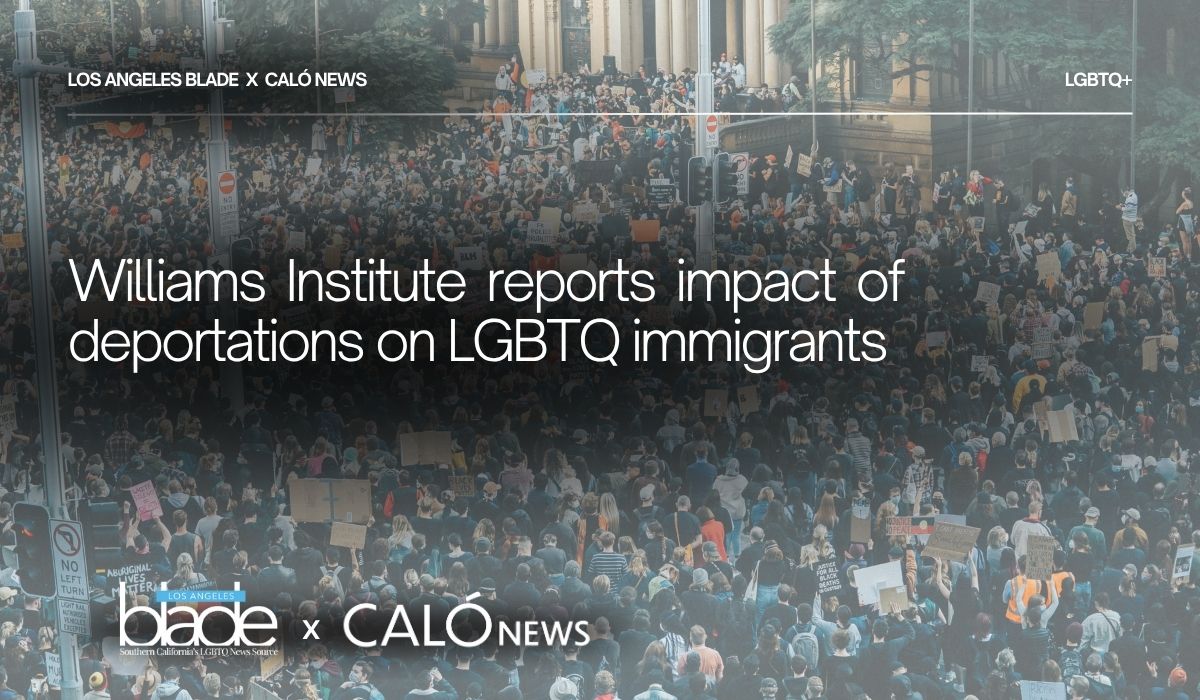
Williams Institute at UCLA has released its latest report, highlighting the intersection between LGBTQ and immigration issues and the impact of the U.S. Customs and Immigration Enforcement (ICE) raids across Los Angeles on LGBTQ people.
According to the brief, LGBTQ immigrants who hold legal status, but who are not naturalized citizens may also face challenges to their legal right to reside in the U.S.
Recent reports indicate that non-citizens with legal status are being swept up in immigration operations and several forms of legal status which were granted at the end of the Biden administration are being revoked. Those include: Temporary Protected Status (TPS) for some Venezuelan immigrants, as well as those from Afghanistan and Cameroon, while Haitian nationals are now facing shortened protection periods, by up to six months.
The Justice Department has proposed a new rule which grants the government border authority to revoke green card holders’ permanent residency status at any time. This rule is currently under review by the Third Circuit Court of Appeals, which could significantly affect non-citizens who are currently documented to reside in the county legally.
Supervisorial District 1, under Supervisor Hilda L. Solis, and Supervisorial District 2, under Supervisor Holly J. Mitchell would particularly be affected as it contains the city center of Los Angeles and nearly 29,000 LGBTQ, noncitizens would face the harshest impact. Those two districts contain many of the county’s historically Black, Latin American and Asian, Pacific Islander neighborhoods.
For transgender, nonbinary and intersex immigrants arrested or detained by ICE, there are additional impacts regarding how federal law defines biological sex and gender identity. The Trump administration has signed an executive order which redefines “sex” under federal law to exclude TGI individuals. This adds an extra thick layer of possible violence when TGI individuals are placed in detention centers or in holding that does not correspond to their identity.
According to the report, ‘transgender, non-binary, and intersex immigrants must navigate an
immigration and asylum system without information about how federal agents will respond to their gender identity and with the risk of greater violence if placed in detention centers, given the effects of this executive order.’
The brief estimates the number or foreign-born adults in Los Angeles County who will be potentially affected by the Trump administration’s executive orders on mass deportations.
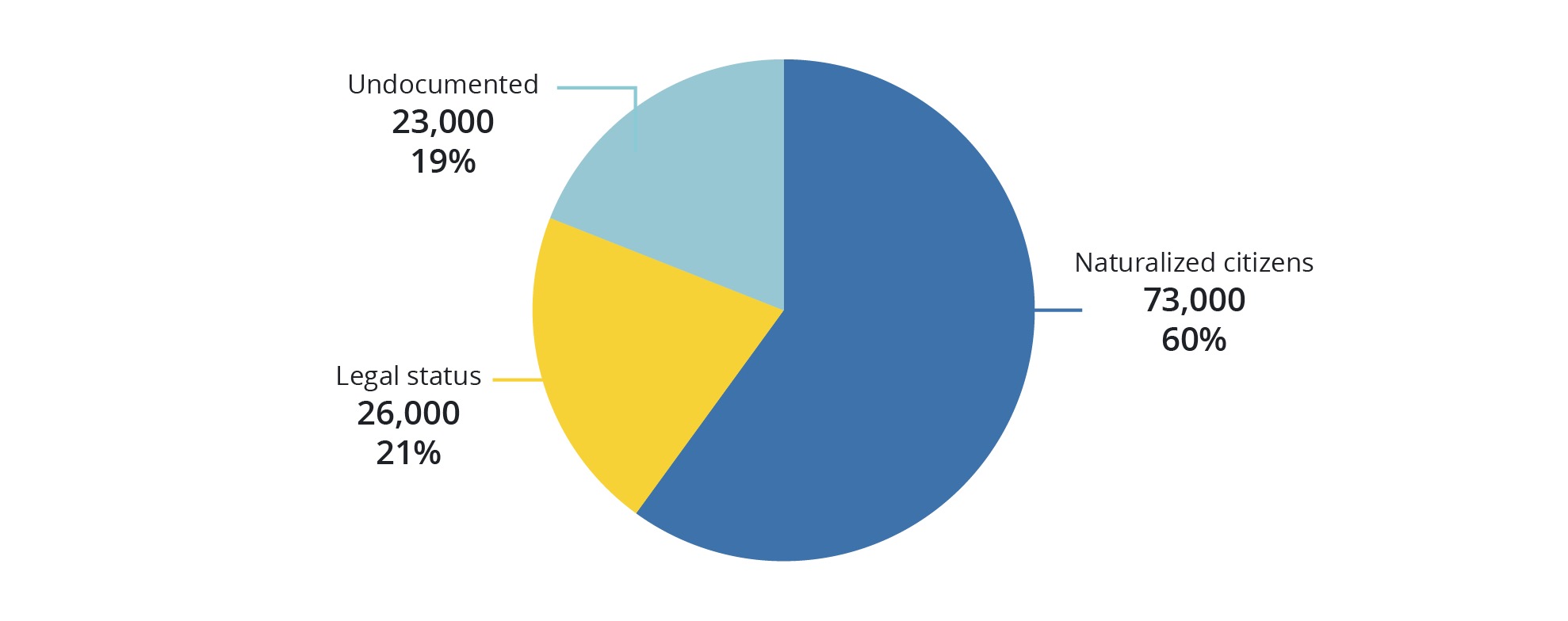
Graphic courtesy of Williams Institute at UCLA.
Using previous data from other Williams Institute Studies and reports from the University of Southern California Dornsife Equity Research Institute and data from the Pew Research Center, the latest brief states that there are over 1.35 million LGBTQ-identifying people across the U.S., with 30% of them residing in California.
The report further points to 122,000 LGBTQ immigrants who reside within LA County specifically, making Los Angeles County home to about 10% of all LGBTQ adult immigrants in the U.S.
While 18% of those Angelenos are foreign-born, only around 7%, or 49,000 of them do not hold legal status.
Using research from the Pew Center and applying an estimate, that means that there are approximately 23,000 undocumented LGBTQ across LA County and the remaining 26,000 LGBTQ immigrants in the county have some form of legal status.
Among the LGBTQ population of adult immigrants in California, approximately 41,000 are transgender or nonbinary. That figure also points toward approximately 5,200 of them residing in LA County. According to the proportions applied for this estimate, the Williams Institute approximates that around 3,100 transgender and nonbinary immigrants in LA County are naturalized citizens, over 1,100 have legal status and just under 1,000 are undocumented.
According to a brief released in February by the Williams Institute, ‘mass deportations could impact 288,000 LGBTQ undocumented immigrants across the U.S.
Health
Excessive heat warning for July 4 weekend
The National Weather Service warns of dangerously high temperatures across the region

LOS ANGELES — As a punishing heat wave grips California, Los Angeles officials have issued an excessive heat warning through July 8, prompting the city to open additional cooling centers and urge residents to take precautions.
The National Weather Service warns of dangerously high temperatures across the region, with some areas expecting highs up to 118 degrees Fahrenheit (47.8 Celsius). Death Valley could see temperatures rise above 130 degrees (55 Celsius).
In response, the City of Los Angeles is opening four augmented cooling centers from July 3 to July 8, operating from 10 a.m. to 9 p.m. daily. These include the Fred Roberts Recreation Center in South Los Angeles, Mid-Valley Senior Center in Panorama City, Lake View Terrace Recreation Center, and Jim Gilliam Recreation Center in Baldwin Hills.
More than 70 Los Angeles public libraries are available as cooling spots during regular hours. Residents can find locations and hours at LAPL.org/Branches.
“We’re taking this heat wave very seriously,” said Mayor Karen Bass. “These cooling centers provide critical relief, especially for our most vulnerable residents.”
City officials advise residents to stay hydrated, limit sugary and alcoholic beverages, and avoid outdoor activities during peak heat hours. They also encourage checking on vulnerable neighbors and keeping pets cool and hydrated.
The heat wave coincides with heightened fire danger in Southern California. A Red Flag Warning is in effect from Thursday evening through Friday night for parts of Ventura County and the Antelope Valley, with gusty winds and low humidity creating critical fire weather conditions.
“If fire ignition occurs, conditions are favorable for extreme fire behavior which would threaten life and property,” the National Weather Service warned.
As the state faces this prolonged period of extreme heat, authorities stress the importance of community awareness and preparedness. Residents are urged to stay informed about local conditions and follow safety guidelines to protect themselves and others from heat-related illnesses and potential fire hazards.
Where to stay cool around the City of West Hollywood:
Plummer Park’s Senior Lounge (7377 Santa Monica Blvd)- The City’s Cooling Center is open during periods of extreme heat (above 90 degrees).
- For more information regarding the City of West Hollywood’s cooling center, please call (323) 848-6530.
- West Hollywood Library (625 N. San Vicente Blvd) – Cooling Center operated by LA County
- Will & Ariel Durant Branch Library (7140 W. Sunset Blvd) – Cooling Center operated by LA County
- West Hollywood Aquatics & Recreation Center (ARC) (8750 El Tovar Pl) – community members can visit the pool to get relief from the heat. For more information, please visit the ARC webpage.
The City provides free transportation to Plummer Park through its Cityline service. Cityline is a friendly and accessible alternative to the larger bus system and all shuttles are ADA-accessible. Cityline operates Monday through Saturday from 9 a.m. to 6 p.m. and shuttles arrive approximately every 30 minutes. For additional information and a detailed route map, visit www.weho.org/cityline.
Safety Tips For Angelenos To Avoid Heat Injury
- Seek shade and refuge from the hot sun if you must be outside.
- Stay hydrated and drink more water, especially if you drink coffee or soda.
- Check in on and prepare your household, family, friends, pets and workplace.
- Limit your exposure to direct sunlight between 10:00 AM and 4:00 PM, when the sun’s rays are strongest.
- If you feel ill, tell someone immediately. Symptoms of dehydration and heat illness may include dizziness, fatigue, faintness, nausea, muscle cramps, headache and vomiting.
- Symptoms of heat stroke include:
- High body temperature (103°F or higher)
- Hot, red, dry, or damp skin
- Fast, strong pulse
- Headache
- Dizziness
- Nausea
- Confusion
- Losing consciousness (passing out)
- In the event of a heat stroke:
- Call 911 right away-heat stroke is a medical emergency
- Move the person to a cooler place
- Help lower the person’s temperature with cool cloths or a cool bath
- Do not give the person anything to drink
- Listen to your body, and remember that those with chronic illness such as asthma, heart disease etc., are more vulnerable to extreme heat. Please take extra precautions.
- Click here for more safety tips from the Los Angeles Fire Department.
- Click here for safety tips in multiple languages including English, Spanish, Armenian, Chinese, Japanese, Korean and more.
Los Angeles County
HONOR PAC launches petition to oust NALEO’s new president over Pride flag vote
Downey City Councilmember Claudia Frometa has faced scathing criticism

In a bold move, HONOR PAC, the leading LGBTQ Latino political action committee, has launched a high-profile petition campaign calling for the removal of Claudia Frometa as the newly elected board president of the National Association of Latino Elected Officials.
The petition, which is spreading rapidly under the hashtags #removeClaudiaFrometa and #PrideFlagSavesLives, comes in response to Frometa’s controversial vote to ban the flying of the Pride flag in Downey. HONOR PAC is rallying NALEO supporters, members, sponsors, and allied organizations to sign on, arguing that Frometa’s actions are incompatible with NALEO’s mission of inclusive representation.
HONOR PAC President Mario Ceballos stated, “We are asking all justice-minded individuals and organizations to stand up in support of LGBTQ+ visibility, pride, safety, and hope. NALEO should be a leader in advancing dignity and civic engagement for all in the United States — not in silencing or making anyone invisible.”
The petition emphasizes the disconnect between NALEO’s recent conference, which highlighted the importance of diversity, equity, and inclusion, and the election of Frometa, who voted against flying the Pride flag in her city. HONOR PAC argues that this decision goes beyond a simple policy change, viewing it as an attempt to erase LGBTQ presence in the community.
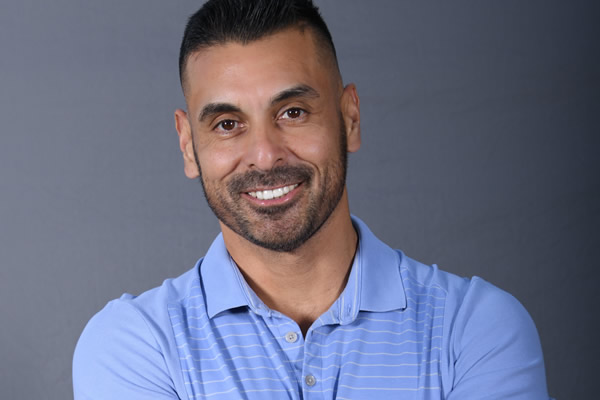
Support for the petition is growing among LGBTQ Latino elected officials.
Huntington Park Councilmember Eddie Martinez, who is the executive director of the Latino Equality Alliance, expressed his disappointment and called for NALEO to address the issue with its LGBTQ membership.
“As a gay man who is also an elected official, I am keenly aware of the importance leadership makes in lifting community and family acceptance of LGBTQ members in the jurisdictions we serve,” he explained. “It is the type of visible and cultural support that can make a difference for the long-term health and mental health of the LGBTQ community and our families.”
“At a time when young Latinos are shown to be disproportionately affected with HIV due to cultural barriers to LGBTQ acceptance, it is critically important our national Latino leaders do all we can to stop homophobia instead of perpetuating it,” he added.
El Monte Councilmember Martin Herrera went further, describing the “neutral flag policy” as “dog whistle politics of anti-LGBTQ hate.”
HONOR PAC is leveraging social media to amplify its message, encouraging supporters to share personal stories about the importance of LGBTQ visibility in Latino communities. The organization is also coordinating with other LGBTQ groups to broaden the campaign’s reach.
As part of their strategy, HONOR PAC is offering resources for supporters to contact NALEO directly, providing template letters and talking points. They’re also planning virtual town halls to discuss the impact of Frometa’s election on LGBTQ Latino representation in politics.
The petition campaign has sparked a broader conversation about the intersection of Latino and LGBTQ identities in American politics. HONOR PAC maintains that NALEO’s choice of leadership sends a powerful message about whose voices are valued within the Latino political community.
“I am surprised to learn that NALEO chose a president who has a track record of opposing the LGBTQ+ community. NALEO has been a proven partner and ally in the fight for LGBTQ+ equality, so I will give them the benefit of the doubt in assuming they were unaware of her anti-LGBTQ+ actions when they elected her. I urge my friends at NALEO to revisit this decision., said Los Angeles County Assessor Jeff Prang, who is president of Los Angeles County LGBTQ+ Elected Officials.
“NALEO’s mission is to ensure full Latino participation in the American political process, and that needs to include LGBTQ+ Latino elected officials. I am alarmed that the organization’s new President actively worked to ensure that the Pride Flag will never be flown over Downey’s City Hall. It is hurtful that NALEO’s Board of Directors would advance someone with a harmful track record against the LGBTQ+ community, especially in a predominately Latino city where our LGBTQ+ youth need to know they are supported and accepted in their hometown. I urge the NALEO Board of Directors to reconsider Councilmember Claudia Frometa’s leadership role and assure all Latino elected officials that NALEO is a safe and affirming space for us,” Alhambra Vice Mayor Sasha Renée Pérez told Los Angeles Blade.
Critics of the petition argue that Frometa’s vote was about government neutrality rather than anti-LGBTQ sentiment. However, HONOR PAC contends that such “neutral” policies often serve to marginalize already vulnerable communities.
However, given Frometa’s past opposition to LGBTQ+ celebrations, neutrality may not be her goal in supporting a ban on the Pride flag.
As Jeff Prang points out, in 2021 Mario Trujillo sponsored a measure in support a Pride celebration hosted by the City of Downey. It passed 4-1 with Frometa as the sole dissent. “Unfortunately,” said Prang, “2”two of councilmembers who voted in favor of Pride in 2021 have left the council and were replaced by LGBTQ opponents.”
As the petition gains momentum, all eyes are on NALEO to see how the organization will respond. The controversy highlights the ongoing challenges of balancing diverse perspectives within identity-based political organizations.
The Los Angeles Blade, which previously broke news of her appointment as president of NALEO’s board, has reached out several times for comment.
Those interested in signing the petition or learning more about the campaign can contact HONOR PAC at [email protected]. The organization is urging supporters to act quickly, emphasizing the critical nature of this moment for LGBTQ Latino representation in national politics.
Los Angeles County
Downey official who banned Pride flag elected to lead influential national Latino political group
Claudia Frometa elected president of the National Association of Latino Elected Officials
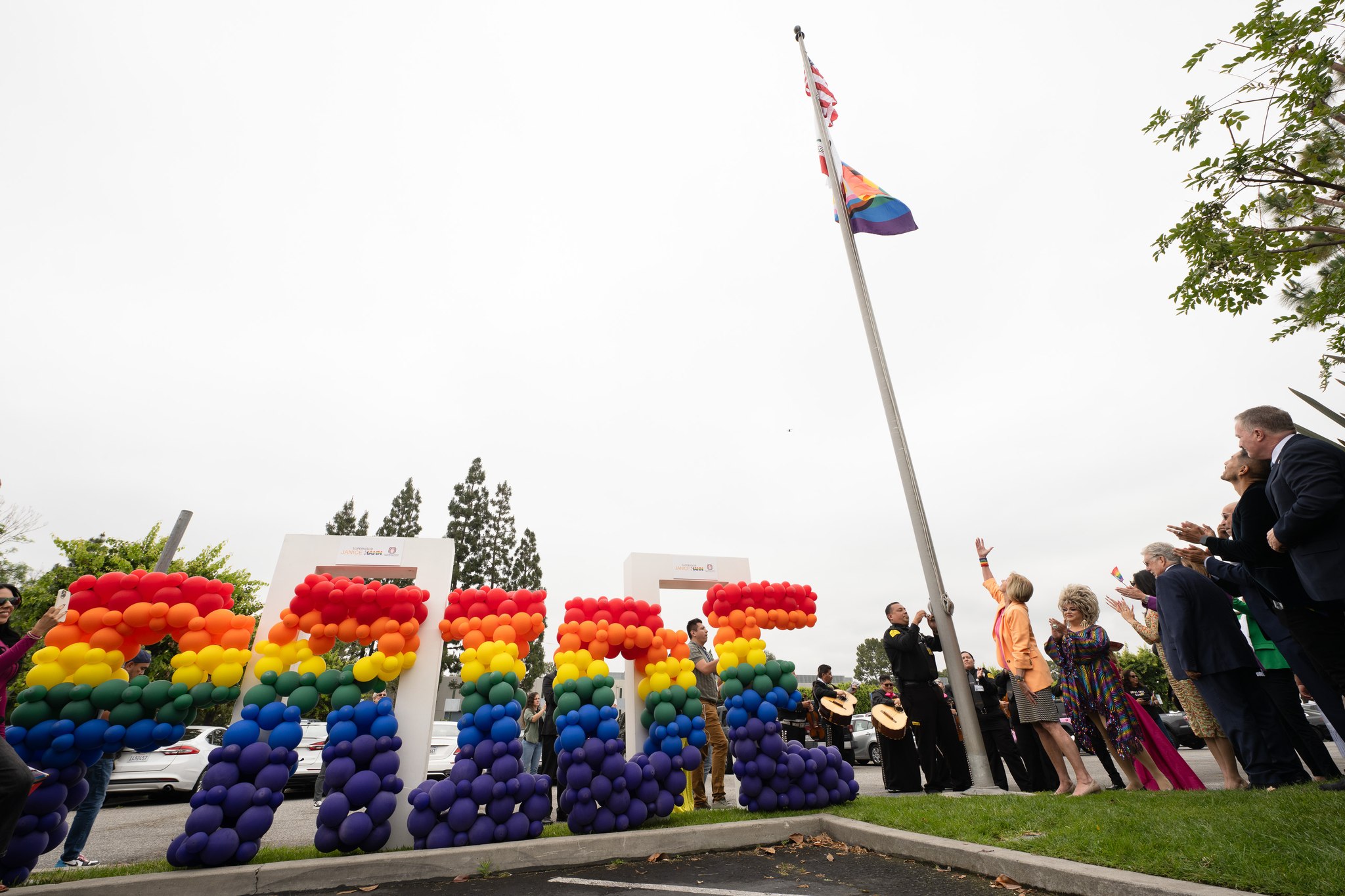
Claudia Frometa, a Downey city councilmember who ardently defended her vote to end the city’s policy of flying the rainbow flag during Pride Month, was elected president of the National Association of Latino Elected Officials during the group’s national conference on June 21.
NALEO, which represents more than 6,800 Latino elected and appointed officials, is an influential political group that was previously led by gay California State Insurance Commissioner Ricardo Lara, who was president of the group in 2020.
Frometa’s election has raised concerns among LGBTQ Latino politicians, including Downey’s gay mayor, Mario Trujillo, who opposed the flag ban.
HONOR PAC, the prominent LGBTQ group that supports Latino candidates, expressed “deep disappointment” in the election of Frometa and posted a statement to Instagram:
“The 2024 NALEO Conference concluded with a clarion call about the importance and power of diversity, equity and inclusion. Ironically, it also just elected @claudiafrometafordowney,
who recently voted to never again allow the city of Downey, (Calif.) to fly the Pride flag, as its newest president,” the statement Mario Ceballos, President of HONORPAC wrote.
“NALEO is an important national leader committed to creating visibility, protecting, and defending justice and equality for all.”
“Many of us at HONOR PAC are naturalized citizens because of NALEO. Our community is better because of NALEO: For these reasons, HONOR PAC is deeply disappointed with the appointment of @claudiafrometofordowney to this important national role.”
“The Pride flag,” the HONOR PAC statement reads, “is a symbol of pride, inclusion, safety, and hope. Ms. Frometa’s vote on a motion disguised as a ‘neutral flag’ policy was nothing more than an attempt to silence and ignore the voices and lives of all LGBTQ+ Downey residents and those who love them.”
HONOR PAC further declared, “Ms. Frometa’s vote on this motion a shameless and violent act against our LGBTQ+ brethren whether they are out of the closet or still struggling to come out of what many know to be a dark and lonely place.”
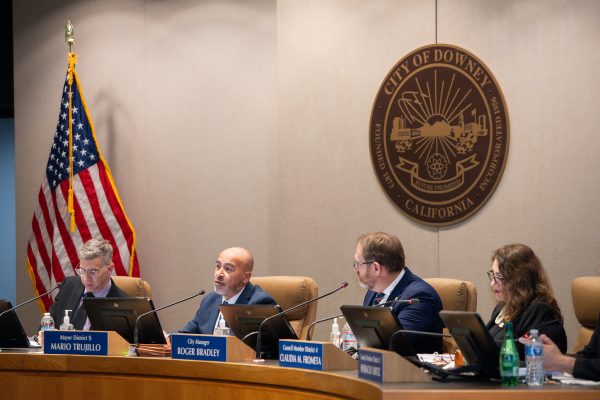
Downey in May voted in favor (a 3-2 vote) of restricting flag flying on city property to only U.S., California and prisoners-of-war flags. The decision reversed a 2021 policy that allowed the Pride flag to be displayed throughout June.
Trujillo maintains the vote was part of an organized political attack on the LGBTQ community, lobbied for by MassResistance, an anti-LGBTQ group classified as a hate group by the Southern Poverty Law Center.
MassResistance has allegedly played a role in opposing and, in some cases reversing LGBTQ supportive programs policies in schools across the nation.
The vote shook the community and sparked a regional backlash, prompting Los Angeles County Supervisor Janice Hahn to organize an Pride flag raising ceremony outside the Los Angeles County Office of Education in Downey on June 3.
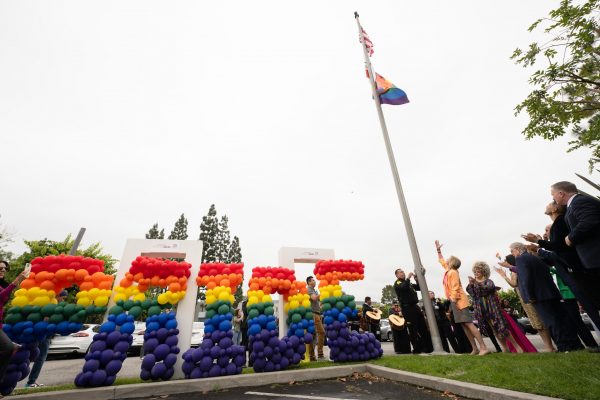
Frometa denied anti-LGBTQ sentiment motivated her vote.
At a June 11 council meeting, Frometa doubled down, “For any individual to say we are anti-LGBTQ community is incorrect,” citing continued funding for the city’s Pride festival.
Supporters of the new flag policy argued that restricting it to official state flags promotes neutrality.
Other Southern California areas have implemented similar flag restrictions, including Huntington Beach, Temecula, and Redlands.
The Los Angeles County LGBTQ+ Elected Officials Association at the time expressed disappointment, stating the Pride flag promotes inclusivity, especially for LGBTQ+ youth.
HONOR PAC’s statement denouncing Frometa’s elevation to the presidency of NALEO concluded with a forceful denouncement which it hopes resonates with the membership of NALEO: “Shame on you @claudiafrometafordowney for not upholding full and equal rights for all so each can pursue his/her/their happiness as our U.S,” the statement concludes.
NALEO plays a critical role in Latino participation in American politics. As its new president, Frometa will lead efforts in leadership development, policy research and advocacy for Latino issues.
Some LGBTQ advocates worry Frometa’s election could indicate gains by anti-LGBTQ groups within Latino political leadership.
“Attending my first NALE0 conference, it was disappointing to learn that the organization’s leadership selected an individual to lead the board after she publicly voted to ban a flag that symbolizes hope for our LGBTQ youth and families in a predominantly Latine/x community. NALEO needs to address this issue with its LGBTQ membership,” noted City of Huntington Park Councilmember Eddie Martinez.
“It is hurtful and disappointing that NALEO, an organization promoting Latino participation in the political process should elevate a member who has disenfranchised LGBTQ+ members of their community, many of whom are Latinx.
“The “neutral flag policy” she helped to pass in her city is nothing more than the dog whistle politics of anti-LGBTQ hate. Such an act is inconsistent with NALEO’s values,” said Martin Herrera, Councilmember, City of El Monte & Secretary of the LA County Lgbtq+ Elected Officials (LACLEO)
“I’m disheartened to see NALEO elect a President that doesn’t stand with the LGBTQ+ community. The actions of their new President do great harm to members of our community and NALEO should be a welcome and opening space for all and not just for some but the actions of their new leader make me doubt their commitment to inclusivity and equality for all,” said West Hollywood Mayor John M Erickson, Ph.D. & LACLEO Boardmember“
I am surprised to learn that NALEO chose a president who has a track record of opposing the LGBTQ+ community. NALEO has been a proven partner and ally in the fight for LGBTQ+ equality, so I will give them the benefit of the doubt in assuming they were unaware of her anti-LGBTQ+ actions when they elected her. I urge my friends at NALEO to revisit this decision., said Jeff Prang, Assessor, Los Angeles County & President, LACLEO
An unnamed LGBTQ politician from Downey told the Los Angeles Blade, “I’m very concerned about the development with NALEO. It’s important that her gaslighting not be forgotten and that it ends. She rode tearing our flag down to national prominence, buoyed by our enemies, and she will continue to blame us for being upset about it. “
Los Angeles County
LA County Pride lifeguard tower at Will Rogers beach vandalized
The tower had homophobic, racist and antisemitic slurs and symbols spray painted on it and its windows were broken out
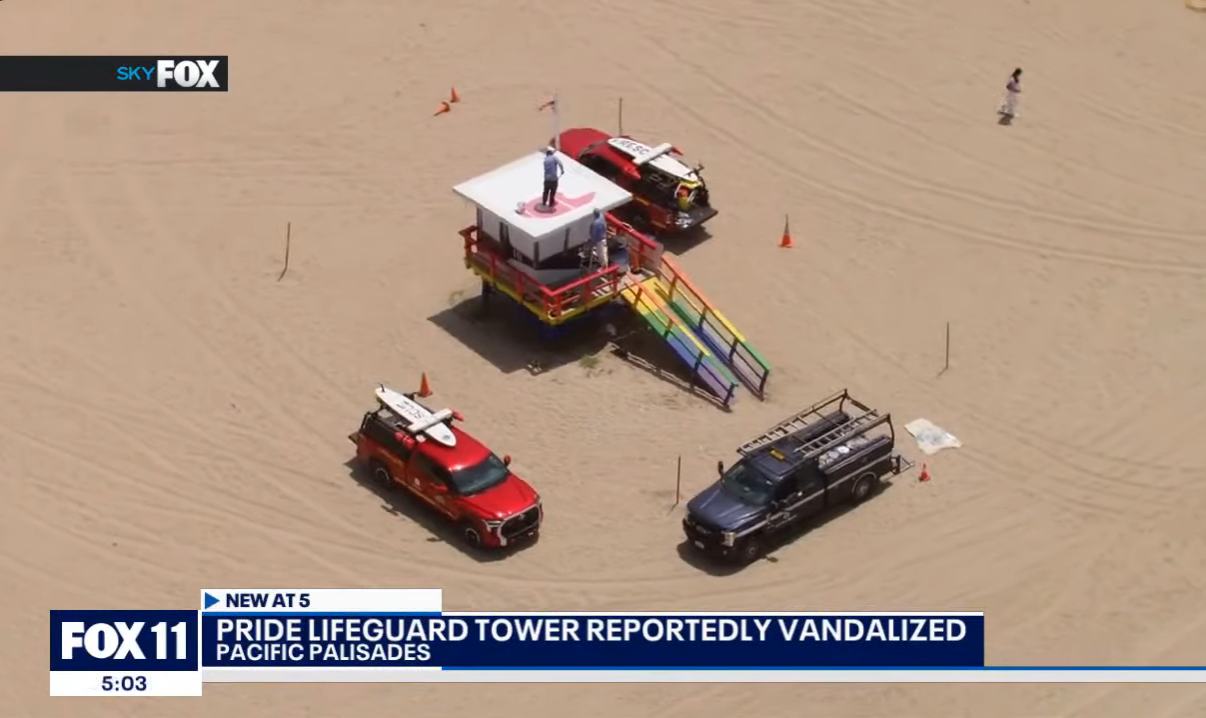
LOS ANGELES – The Los Angeles County lifeguard tower at Will Rogers State Beach was vandalized Monday evening or early Tuesday morning with homophobic, racist and antisemitic slurs and symbols were spray painted on it and the windows were broken out.
“Hate has no place in Los Angeles County. We will not back down from celebrating and protecting our LGBTQ+, Jewish, and Black communities – among our many diverse communities – across Los Angeles County. This act of hatred reminds us why our continued commitment to solidarity is necessary,” L.A. County Supervisor Lindsey Horvath said in a statement to the Blade. “We are working with our County departmental partners to repaint Lifeguard Tower 18 at the historic and beloved Ginger Rogers Beach.”
WATCH:
Los Angeles County
LAUSD board votes to ban student cellphone use during school day
Mobile phone apps are often cited as the leading cause among adolescents to suffer from episodes of mental health crisis or being bullied
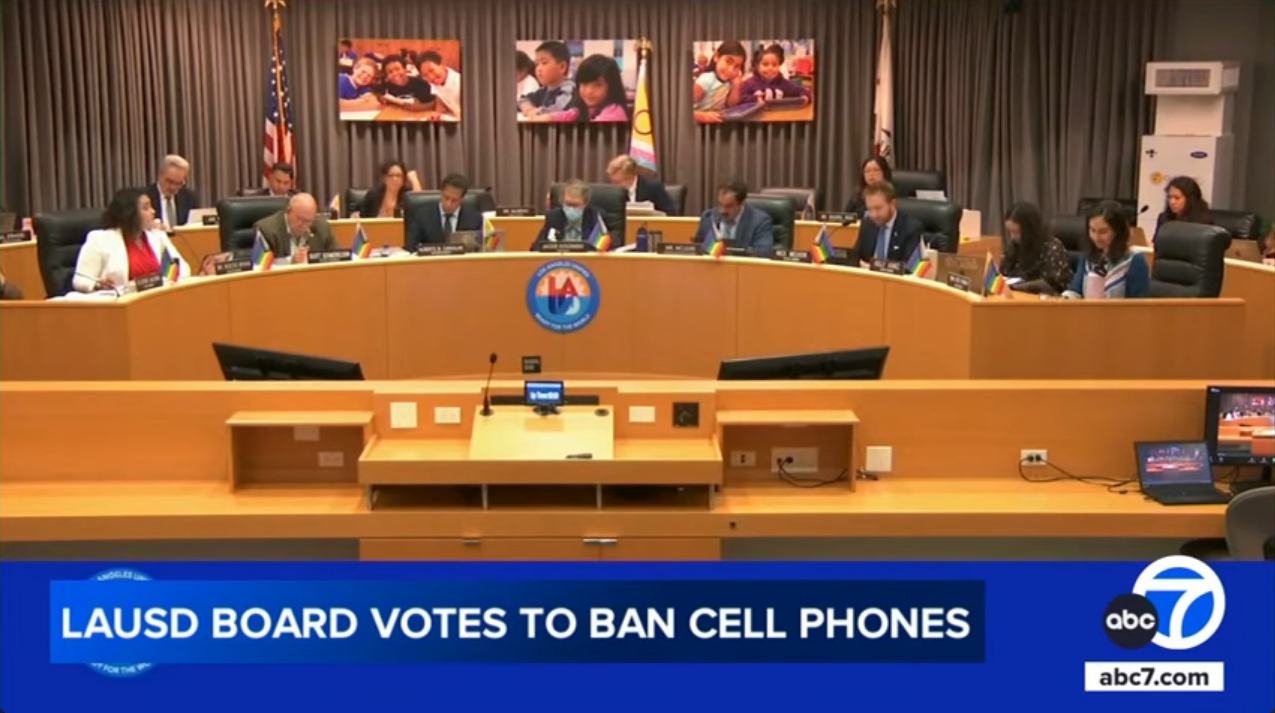
LOS ANGELES – The Los Angeles Unified School District (LAUSD) voted Tuesday to ban mobile phone use during the school day starting in January of 2025. The ban is a complete prohibition against access and use of mobile phones by students on all LAUSD school campuses, including break periods.
“No matter what we bring to the board in the next four months, it will come with an awareness campaign for all stakeholders including students, but advances also the critical element of pursuing litigation against social media giants for their careless, irresponsible and immoral actions that have put kids across the country in the position they’re in today,” said LAUSD Superintendent Alberto Carvalho.
There was dissension as two school board members opposed the ban citing how difficult it would be for employees of the second largest school district in the country to enforce the ban and stay on top of it, KABC 7 reported.
Nick Melvoin, the LAUSD school board member for District 4, who spearheaded the ban, spoke with KABC 7:
“When I talk to teachers and students and parents… I also hear the same, which is that more and more time is being spent on policing student phone use. There’s not a coherent enforcement and they’re looking for some support from the board and from the district,” Melvoin said Tuesday. “The schools that have gone farther and that have already implemented a phone-free school day report incredible results. Kids are happier, they’re talking to one another, their academics are up.”
Some parents and others are opposed to the ban telling KABC that they wanted to be able to communicate with their children. Others however see the ban as a means to improve learning and lead to less bullying.
With mobile phone apps most often cited as the leading cause among adolescents to suffer from episodes of mental health crisis or being bullied as is a majority of cases for LGBTQ+ youth, especially trans and gender non-conforming youth, limiting school day usage could mitigate a portion of those instances a San Fernando Valley youth mental health crisis counselor, who asked to remain unidentified, told the Blade Tuesday afternoon.
Related:
Los Angeles County
New on the LA County Channel
You can watch on Channel 92 or 94 on most cable systems, or anytime here. Catch up on LA County Close-Up here
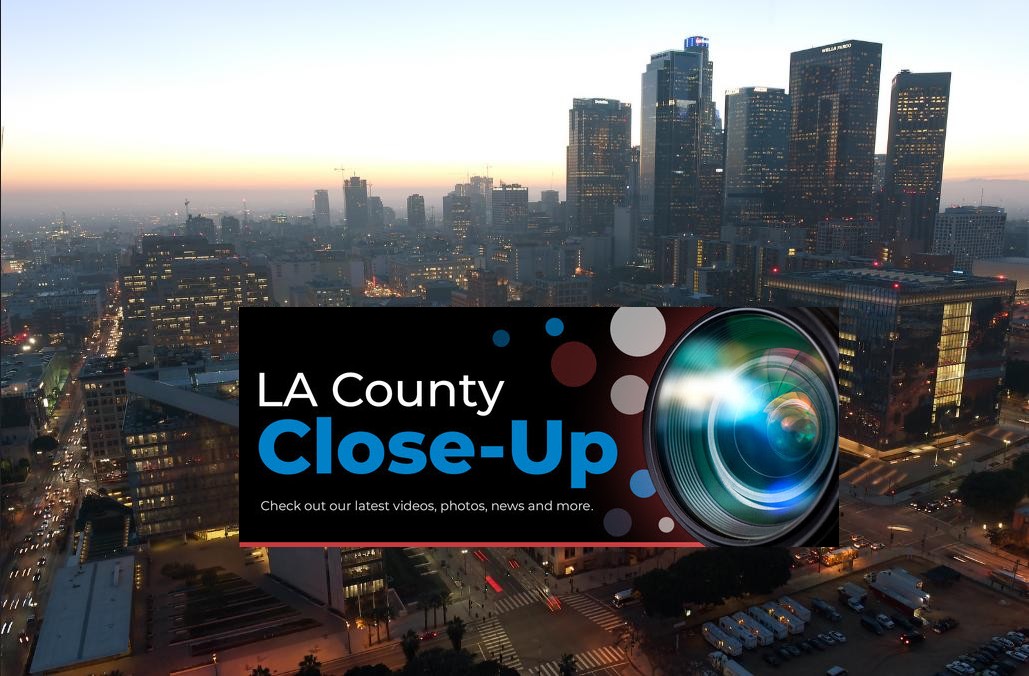
New on the County Channel
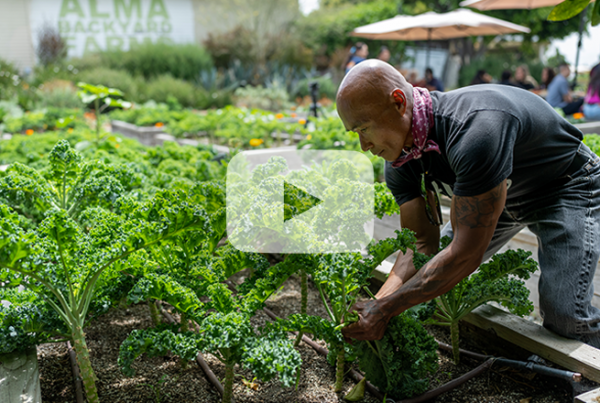
A Food Equity Grant Program funded by LA County and the American Rescue Plan helps community organizations like Alma Backyard Farms create a new food system for County residents.
You can watch more stories like this on Channel 92 or 94 on most cable systems, or anytime here. Catch up on LA County Close-Up here.
Celebrating Juneteenth
In celebration of Juneteenth 2024 and as a representation of the County’s commitment to the hard but necessary work of reparations, the County will provide free admission and access on or around June 19, 2024, to participating museums and beaches in Los Angeles County for eligible LA County residents who are lineal descendants of an African-American Chattel enslaved person (descendants of enslaved people who were abducted from their African homelands by force to be enslaved in North America) or of a free African-American person living in the United States prior to the end of the 19th Century (“Community of Eligibility Residents”).
To receive free museum admission and beach parking on or around June 19, 2024, as described above, and be considered for eligibility in any future reparations or benefits under the County’s Reparations Initiative or any other applicable local or state program, please click here.


Join LA County in celebrating Juneteeth at Supervisor Holly J. Mitchell’s 4th Annual Juneteeth Celebration and Resource Fair on Friday, June 21, from 4:00 p.m. to 8:00 p.m. This event features music, food trucks, live performances, access to County services, resources, fun activities, and more! All residents are welcome to attend this FREE event. We encourage you to register and forward this email to your friends and neighbors! Register here.
In Case You Missed It
The Works App

From reporting potholes to finding critical services, it’s LA County at your fingertips.
The Works App empowers you to report:
- Issues like potholes, graffiti, overgrown trees, and blocked storm drains
- Property-related concerns and suspected violations
- Illegal dumping activities affecting our streets and environment
- Maintenance needs of trails and facilities in County parks
Keep up to date with the County’s latest news on upcoming events. Locate the nearest LA County offices, libraries, shuttle buses, and other services.
Download The Works for iPhone or Android today and transform how you connect with LA County!
At Your Service
Boost Your Business and Elevate a Career
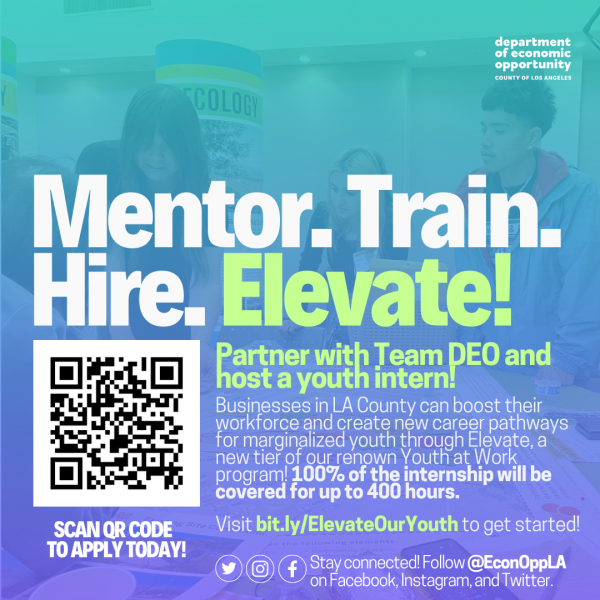
Partner with the LA County Department of Economic Opportunity through Youth at Work Elevate to get your business matched with a highly motivated youth intern.
Potential youth participants between the ages of 17-24 in will receive paid work experience, training, and mentorship to prepare youth for in-demand and diverse career pathways. 100% of the youths’ wages will be covered for up to 400 hours.
Businesses in high-growth or post pandemic emerging sectors including healthcare, infrastructure, trade and logistics, e-commerce, transportation and warehousing, advanced manufacturing, entertainment and creative arts, informational technology, and hospitality are encouraged to apply.
A dedicated representative will be assigned to help eligible businesses through the entire process. Youth eligibility requirements include: Current or former foster youth, justice-impacted, current or previous experience with housing instability/homelessness, and LGBTQ+ youth.
Learn more here.
Out and About
Parks After Dark Returns

Parks After Dark is Back for the 2024 Summer Season! Enjoy FREE Activities at 34 LA county parks! Join us for concerts, movie nights, fitness and wellness activities, food, games and more! F Also returning this year is our “Resource Fair Thursday’s”. To learn more, click here.
Photo Finish

(Photo: Los Angeles County/Mayra Beltran Vasquez)
Click here to access more photos of LA County in action.
Los Angeles County
LA County Public Health: Mpox cases rise & data privacy breach
Ten new Mpox cases reported in Los Angeles County in past two weeks cause concern as agency reels from a successful phishing attack
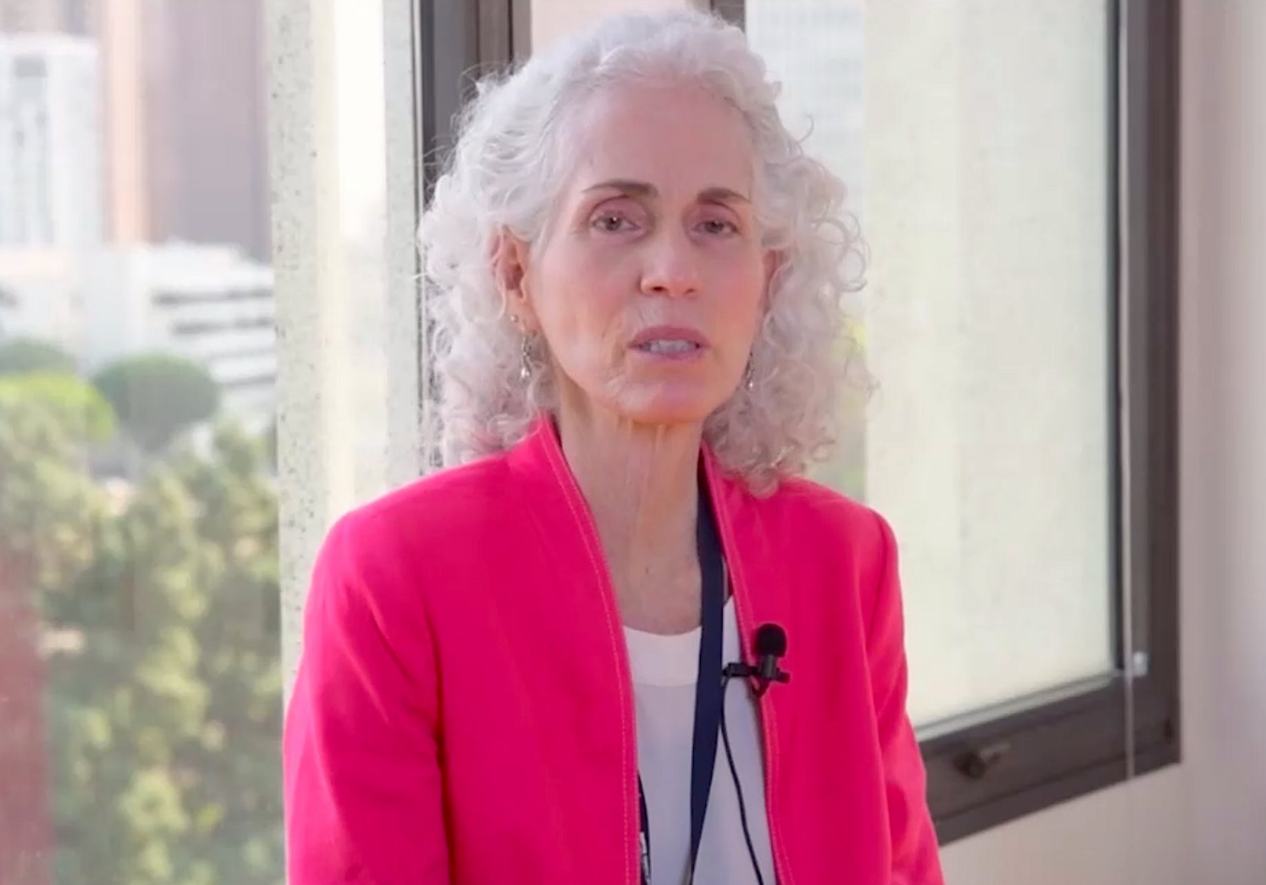
LOS ANGELES – The Los Angeles County Department of Public Health is alerting residents and health care providers about a concerning increase in mpox cases, with 10 new cases reported in Los Angeles County in the past two weeks up from an average of less than two cases per week during the preceding several weeks.
Mpox (previously referred to as Monkeypox) is mainly spread through close contact with body fluids, sores, shared bedding or clothing or respiratory droplets (kissing, coughing, sneezing). Symptoms include rash or unusual sores that look like pimples or blisters on the face, body and genitals, fever, chills, headache, muscle aches or swelling of lymph nodes. Early detection, testing and vaccination are vital to controlling the spread of this disease and protecting the health of Los Angeles County residents.
Given the recent increase in cases, Public Health strongly recommends the following actions:
Testing: Anyone who develops symptoms consistent with mpox, such as rash, fever or swollen lymph nodes should seek medical attention and get tested. Health care providers should be aware of the possibility of mpox and promptly report suspected cases to Public Health for appropriate testing and interventions.
Prevention: Vaccination is a safe way to prevent one from getting mpox and may also reduce symptoms. The following can help reduce the risk of getting and spreading mpox:
- Ask partners if they have mpox symptoms or feel sick. Individuals should not have sex or other intimate contact if they or their partners have a new or unexplained rash or sores or feel sick until they see a health care provider.
- Reduce the number of partners, especially those whose recent sexual history is unknown.
- Make a habit of exchanging contact information with any new partner to allow for sexual health follow-up, if needed.
- Limit going to sex parties, circuit parties and other spaces where people are having sex or other intimate contact with multiple people.
- Use condoms and gloves:
- Condoms (latex or polyurethane) may protect the mouth, penis anus or vagina from exposure to mpox; however, condoms alone may not prevent all exposures to mpox since the rash can occur on other parts of the body.
- Gloves (latex, polyurethane or nitrile) may reduce exposure if inserting fingers or hands into the anus or the vagina. The gloves must cover all exposed skin and be removed carefully to avoid touching the outer surface.
- Do not share towels, clothing, bedding, fetish gear, sex toys or toothbrushes.
- Wash hands, fetish gear, towels and bedding. Sex toys should be washed after each use or sex act.
Vaccination: Vaccination is an important tool in preventing the spread of mpox. Jynneos is a two-dose vaccine developed to protect against mpox, and getting both doses provides the best protection against mpox. The vaccine is available to anyone, and individuals who identify with any of the following subgroups are highly encouraged to get vaccinated:
- Any man or transgender person who has sex with men or transgender persons
- Persons of any gender or sexual orientation who have sex or intimate physical contact with others in association with a large public event or engage in commercial and/or transactional sex
- Persons living with HIV, especially persons with uncontrolled or advanced HIV disease
- Sexual partners of people in any of the above groups
People in high-risk groups are urged to get fully vaccinated with two doses for the best protection. Second doses can be given no matter how long it’s been since the first dose. Residents can choose to receive the mpox vaccine subcutaneously (in the upper arm) or intradermally (under the skin on their arm or back). Vaccine boosters are not recommended at this time.
Public Health is collaborating closely with health care providers, community organizations and other stakeholders to address the mpox resurgence as swiftly and effectively as possible. Enhanced surveillance, contact tracing and outbreak investigations are underway to identify potential sources of the infection and prevent further transmission. Public Health’s mobile vaccination units are providing free vaccination at numerous Pride events this season, Public Health’s sexual health clinics found at http://publichealth.lacounty.gov/chs/sexualhealthclinics/ and other walk-up vaccine clinics can be found at https://myturn.ca.gov/.
A collective response is crucial in mitigating the impact of this outbreak. By increasing vaccination rates, the spread of mpox can be minimized within Los Angeles County to protect the health and well-being of its diverse communities.
For the most up-to-date information and resources, please visit ph.lacounty.gov/mpox or contact the Public Health Call Center at 1-833-540-0473.
Public Health Responds to Privacy Breach
Between February 19, 2024, and February 20, 2024, the Los Angeles County Department of Public Health experienced a phishing attack in which a hacker was able to gain log-in credentials of 53 Public Health employees through a phishing email, compromising the personal information of more than 200,000 individuals.
Upon discovery of the phishing attack, Public Health disabled the impacted e-mail accounts, reset and re-imaged the user’s device(s), blocked websites that were identified as part of the phishing campaign and quarantined all suspicious incoming e-mails. Additionally, awareness notifications were distributed to all workforce members to remind them to be vigilant when reviewing e-mails, especially those including links or attachments. Law enforcement was notified upon discovery of the phishing attack, and they investigated the incident.
The information identified in the potentially compromised e-mail accounts may have included DPH clients/employees/other individuals’ first and last name, date of birth, diagnosis, prescription, medical record number/patient ID, Medicare/Med-Cal number, health insurance information, Social Security Number, and other financial information.
Affected individuals may have been impacted differently and not all of the elements listed were present for each individual.
Public Health is notifying impacted individuals by mail. For individuals where a mailing address is not available, Public Health is also posting a notice on its website to provide information and resources. Public Health is also notifying the U.S. Department of Health and Human Services’ Office for Civil Rights and other agencies as required by law and/or contract.
In response, Public Health has implemented numerous enhancements to reduce exposure to similar e-mail attacks in the future.
While Public Health cannot confirm whether information has been accessed or misused, individuals are encouraged to review the content and accuracy of the information in their medical record with their medical provider. To help relieve concerns and restore confidence following this incident, we have secured the services of Kroll, a global leader in risk mitigation and response, to provide identity monitoring for one year at no cost to affected clients.
Additionally, affected individuals should review “Steps You Can Take to Protect Against Identity Theft and Fraud,” to help protect their information.
Individuals that would like to inquire if their information was impacted can contact the following established dedicated call center available toll free in the U.S. at 1-866-898-4312, from 6:00 a.m. to 5:00 p.m. Pacific Time (excluding weekends and major U.S. holidays).
Los Angeles County
New on the LA County Channel
You can watch on Channel 92 or 94 on most cable systems, or anytime here. Catch up on LA County Close-Up here

New on the County Channel

The Veteran Peer Access Network (VPAN) is the first community-driven support network serving veterans and their families in the U.S. Led by veterans for veterans, VPAN connects L.A. County Departments, nonprofits, the V.A., and L.A. City Programs to help veterans navigate often complicated systems to connect to resources. VPAN prioritizes hiring veterans as “battle buddies” and systems navigators to connect assist their fellow veterans.
You can watch more stories like this on Channel 92 or 94 on most cable systems, or anytime here. Catch up on LA County Close-Up here.
In Case You Missed It
Arts Internship Program – Apply Today!

Positions for the 2024 Arts Internship Program are now available! This program will provide 228 university and community college students with paid on-the-job experience in the arts at over 160 nonprofit organizations across the LA region. What’s more, all Arts Internship Program internships provide 400 hours of work experience at $17.28 an hour.
Positions will continue to be posted on a rolling basis through July 2024. Visit the LA County Arts & Culture website to learn more!
At Your Service
The Works App

From reporting potholes to finding critical services, it’s LA County at your fingertips.
The Works App empowers you to report:
- Issues like potholes, graffiti, overgrown trees, and blocked storm drains
- Property-related concerns and suspected violations
- Illegal dumping activities affecting our streets and environment
- Maintenance needs of trails and facilities in County parks
Keep up to date with the County’s latest news on upcoming events. Locate the nearest LA County offices, libraries, shuttle buses, and other services.
Download The Works for iPhone or Android today and transform how you connect with LA County!
Out and About
Celebrating Juneteenth

Join LA County in celebrating Juneteeth at Supervisor Holly J. Mitchell’s 4th Annual Juneteeth Celebration and Resource Fair on Friday, June 21, from 4:00 p.m. to 8:00 p.m. This event features music, food trucks, live performances, access to County services, resources, fun activities, and more! All residents are welcome to attend this FREE event. We encourage you to register and forward this email to your friends and neighbors! Register here.
To learn more about Juneteeth and find events and programming in your community, click here.
Photo Finish

Click here to access more photos of LA County in action.
Los Angeles County
Parks make life better month- Culver City’s movies in the park
California’s “Parks Make Life Better!” recognizes the importance of equitable access to parks, recreation, trails, open space, & facilities
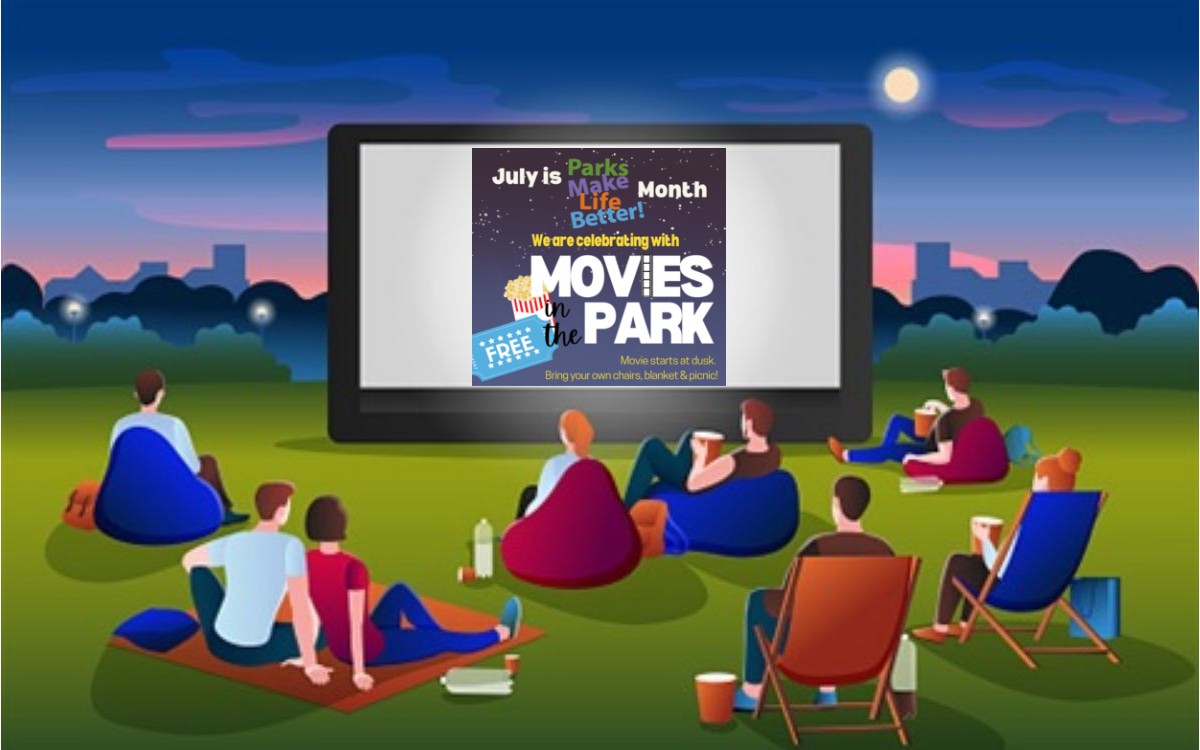
CULVER CITY, Calif. – July is “Parks Make Life Better!” month and the Parks, Recreation and Community Services Department is celebrating with Movies in The Park every Saturday night, all month long!
Bring your blankets, picnic baskets, and lawn chairs to see:
- Barbie at Veterans Memorial Park on July 6th
- Mary Poppins at Syd Kronenthal Park on July 13th
- Wonka at Fox Hills Park on July 20th
- The Wizard of Oz at Culver West Alexander Park on July 27th
Gates will open at 7 PM and movies will begin at dusk. Admission is free.
The California “Parks Make Life Better!” campaign recognizes the importance of equitable access to parks, recreation, trails, open space, and facilities for the positive development of all. Culver City PRCS invites you and your family to celebrate with us.

PARKS MAKE LIFE BETTER MONTH
MOVIE SCREENINGS
WHEN
Saturday July 6, 13, 20, and 27
7 PM gates open, movie starts at dusk
WHERE
- Veterans Memorial Park on 7/6
- Syd Kronenthal Park on 7/13
- Fox Hills Park on 7/20
- Culver West Alexander Park on 7/27
-
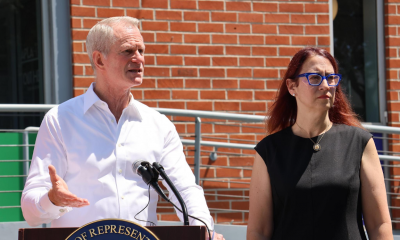
 Breaking News3 days ago
Breaking News3 days agoMajor victory for LGBTQ funding in LA County
-

 Features2 days ago
Features2 days agoKoaty & Sumner: Finding love in the adult industry
-
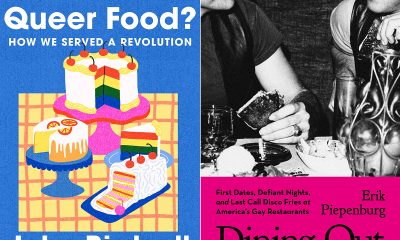
 Books5 days ago
Books5 days agoTwo new books on dining out LGBTQ-style
-
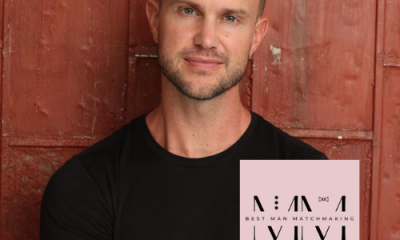
 Miscellaneous2 days ago
Miscellaneous2 days agoCan you really find true love in LA? Insights from a queer matchmaker
-

 Commentary11 hours ago
Commentary11 hours agoBreaking the mental health mold with Ketamine: insights from creator of Better U
-
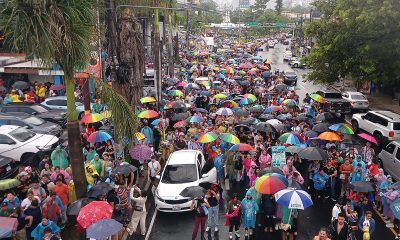
 El Salvador3 days ago
El Salvador3 days agoLa marcha LGBTQ+ desafía el silencio en El Salvador
-

 Arts & Entertainment2 days ago
Arts & Entertainment2 days agoIntuitive Shana gives us her hot take for July’s tarot reading

